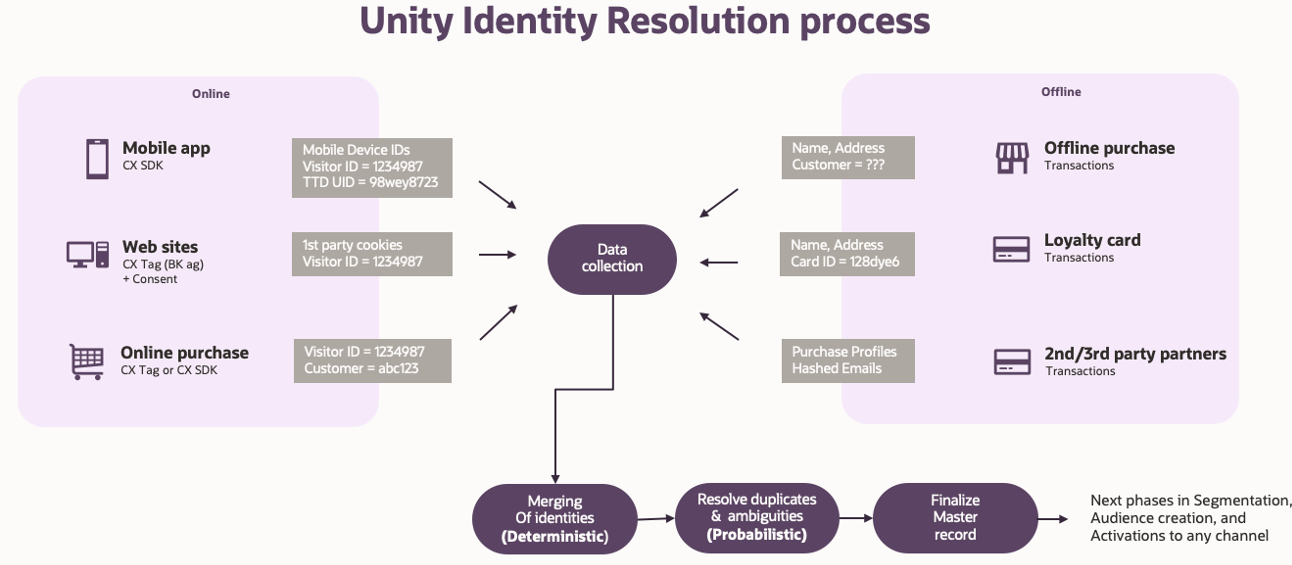Customers today engage with brands across numerous channels, creating multiple fragmented identities. Imagine a customer first interacting with an online retailer by browsing products anonymously on their smartphone. They later create an account on their laptop to get 10% off their purchase and complete the process. A week later, they visit a physical store location to return one of them items and purchase a different one. Without a way to connect these interactions, the brand views them as three separate, unrelated events.
This disconnect in customer data and fragmented identities creates challenges for brands trying to deliver seamless and personalized experiences. These challenges include:
- Customer journey disruption: Brands struggle to piece together customer behaviors, resulting in inconsistent and disconnected experiences.
- Personalization gaps: Without a unified view, personalization becomes generic and fails to resonate with customers.
- Missed opportunities for loyalty: This fragmentation prevents brands from understanding customer preferences, leading to lower satisfaction and loyalty.
- Inefficient marketing spend: Marketing teams waste resources targeting the same customer across multiple profiles or miss out on opportunities for precise engagement.
Identity resolution -Connect the dots of customer behavior to provide personalized experiences
So how can you help customers if you don’t know who they are or how they interact with your brand? Identity (ID) resolution solves this problem. By linking fragmented customer identifiers—such as device IDs, phone numbers, cookies, email addresses, loyalty program IDs or really anything else —you can start to build a clearer view of customers across their offline and online interactions and anticipate their needs.
Why identity resolution? Once you’ve identified your customers, you can track their online and offline interactions with your brand and create a single, unified view of their behaviors. With this customer profile, you can:
- Analyze their past behaviors.
- Build a cohesive view of their interests, preferences, and needs.
- Craft meaningful interactions and personalized experiences.
What channels do your customers frequent? Which events, offers, and messaging bring them back? What purchases or deals resonate most? A well-constructed customer profile delivers actionable insights into what customers expect across marketing, service, sales, and commerce.
Identity resolution challenges
How useful your customer profiles are depends on the quality of your data. If your data is incomplete or poorly managed, you’ll have an unclear picture of your customers. This can happen due to:
- Poor and siloed data management: Storing and managing massive amounts of data can be overwhelming. Siloed systems across your business may prevent you from linking data correctly, hindering actionable customer insight.
- Incomplete information: If your data isn’t cleaned and organized, gaps in customer profiles emerge, limiting your ability to improve interactions with customers.
- Data privacy concerns: Customers are also sensitive to the data they offer to businesses and how it’s used.
Difficulties in implementing identity resolution
Implementing identity resolution comes with its own set of challenges. Typically, there are two approaches for it:
- Probabilistic: Uses algorithms to predict if identifiers belong to the same person, analyzing data like browsing behavior, device type, and location. It potentially increasing reach but is less accurate and has a higher risk of incorrectly linking data.
- Deterministic: Relies on direct matches between strong identifiers like email addresses and login IDs to definitively link data to an individual. This approach offers high accuracy but may limit reach due to fewer linked identifiers.
Which approach is right for you? It depends on your outreach goals—whether broad or narrow—and whether you have the right identity resolution solution to support your strategy.
The right identity resolution solution—a CDP
A Customer Data Platform (CDP) enables you to implement identity resolution using either a probabilistic or deterministic approach. It connects the dots between customer actions online and offline, offering valuable insights. With a probabilistic approach, you can manage broader, more expansive outreach. However, a CDP truly shines with a deterministic approach, allowing for highly accurate, focused, and personalized engagement.
For instance, continuing from the previous example, the retailer uses a CDP to consolidate a customer’s browsing data, purchase history, and in-store interactions into a unified profile. This unified view allows the retailer to deliver tailored product recommendations via email, in-app notifications, and personalized ads. Whether the customer browsed a new collection online, purchased an item in-store, or used the mobile app to check order status, the retailer can craft a seamless, consistent experience across all touchpoints.
Implement a CDP to build trust and personalize customer experiences
A CDP doesn’t just unify data—it helps you manage it better by breaking down silos and connecting information across your business. This ensures that customer consent is respected, data is used responsibly, and privacy laws are upheld, fostering trust and transparency.
With a CDP, you can:
- Organize and store data more effectively.
- Pinpoint customer identities with greater accuracy and build detailed profiles.
- Continuously enrich profiles with new data to enhance personalization and relevance.
- Optimize segmentation, targeting, analytics, messaging, and offers.
- Deliver superior customer experiences by leveraging connected data and actionable insights.
By consolidating customer data, a CDP empowers your brand to deliver tailored experiences while fostering trust and maintaining compliance.
Introducing Oracle Unity CDP
Unity applies both deterministic and probabilistic identity resolution simultaneously, offering brands a comprehensive and robust approach to unify customer data. This dual capability ensures precise identification while also expanding the reach and depth of insights, enabling brands to maintain accuracy and personalization in their customer interactions.

A standout feature of Oracle Unity is its ability to extend identity resolution beyond individual customers and accounts, allowing marketers to build profiles for any unique object within the CDP. For instance, Oracle Unity can unify data for a vehicle, allowing brands to maintain continuity in interactions, such as tracking service history, sending maintenance reminders (e.g., “Time to bring your car in for maintenance”), and personalizing communications even if the car changes ownership. This ensures a seamless customer experience and strengthens brand loyalty.
Another example is building a single view of a brick-and-mortar location. With this capability, brands can identify customers who frequent a specific store, understand which products are most popular, and analyze how their shopping behaviors differ from customers at other locations. This insight enables brands to tailor local marketing strategies and improve the in-store experience.
By seamlessly integrating back-office and front-office data, Oracle Unity empowers brands to create robust 360-degree profiles that drive consistent and personalized engagement across advertising, marketing, sales, and service systems
Additional resources
Learn more about Oracle Unity CDP
See Oracle Unity CDP in Action
This blog post was originally published on Mar. 16, 2022 by Michael McNichols
